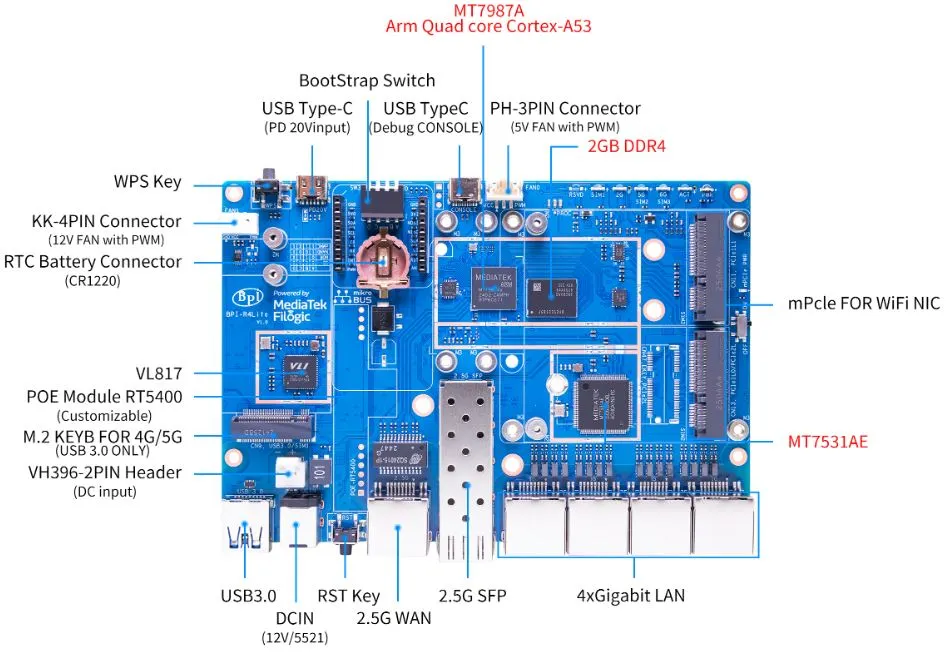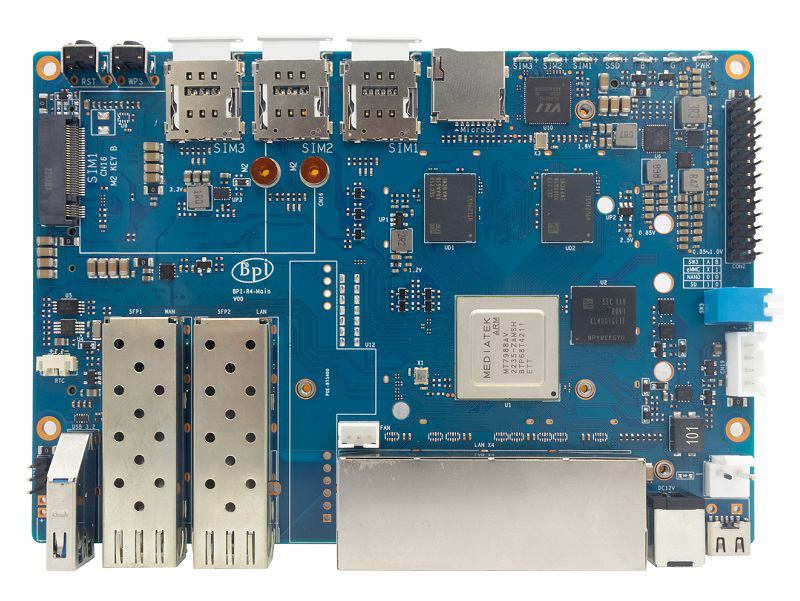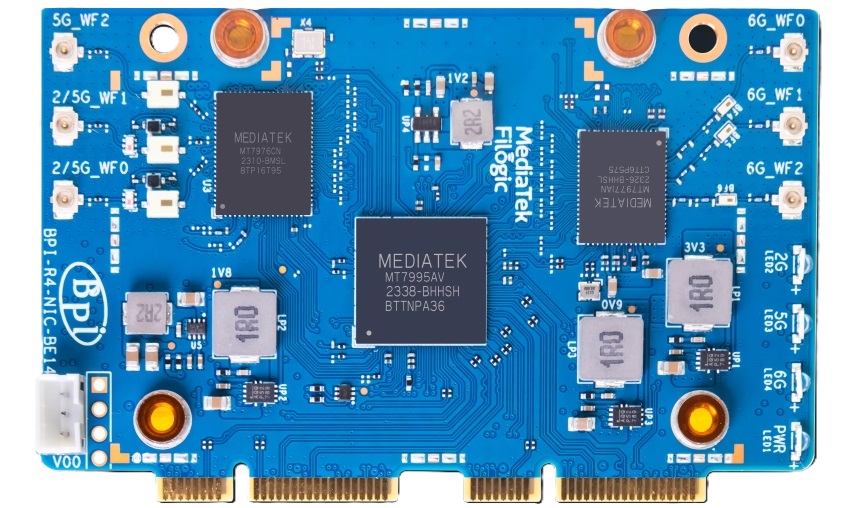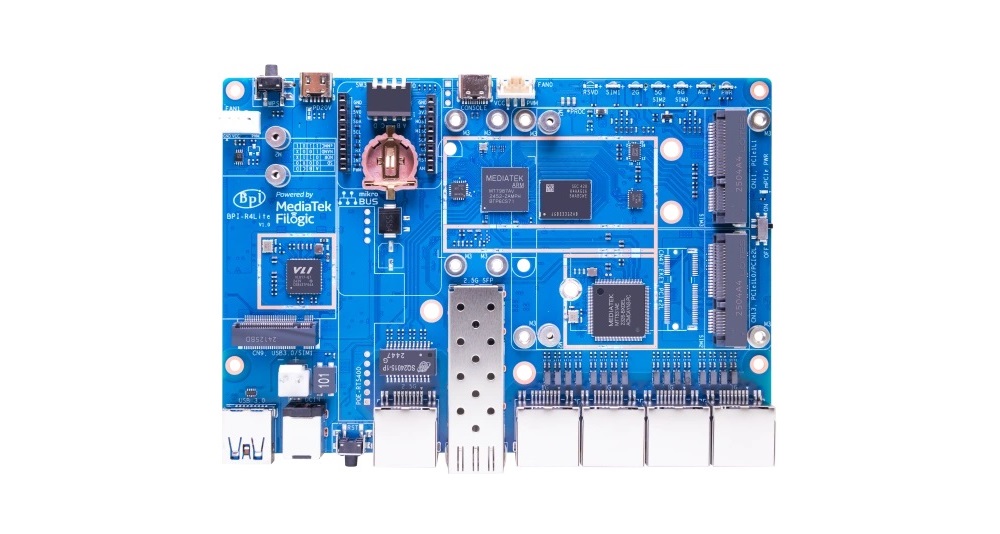Table of Contents
- Maybe you missed it? Review of the Banana Pi R4.
- Banana Pi BPI-R4 Lite Announcement: Overview and Key Features.
Banana Pi BPI-R4 Lite now available
The Banana Pi BPI-R4 Lite is the latest addition to the Banana Pi router board family, offering a more affordable alternative to the previous BPI-R4 model. Designed as a cost-effective solution for home networking, small offices, and educational projects, the BPI-R4 Lite packs a punch with its impressive features and capabilities. This single-board computer is powered by a MediaTek MT7987A quad-core ARM Cortex-A53 processor, making it suitable for a wide range of applications, from basic computing tasks to network infrastructure setups.
A closer look at the board, its components, and interfaces.

A rearview perspective on the board interfaces.

Here’s a neatly organized table summarizing all the specifications:
| Category | Details |
|---|---|
| CPU | MediaTek MT7987A |
| Architecture | Quad-core Arm Cortex-A53 |
| Memory / Storage | – 2GB DDR4 RAM (supports up to 4GB) – 8GB eMMC flash – 256MB SPI-NAND flash – 32MB SPI-NOR flash – MicroSD (TF) card slot for storage expansion |
| Networking | – 1× 2.5G SFP port – 1× 2.5G RJ45 WAN port (PoE optional with module) – 4× 1G RJ45 LAN ports – Supports Wi-Fi 6 / Wi-Fi 7 (via expansion NIC) |
| Expansion | – 2× miniPCIe slot with PCIe 3.0 (2-lane) for Wi-Fi 7 NIC – – 1× M.2 Key-B slot with USB 3.0 for 4G/5G modules – 2× 8-pin MikroBUS headers (UART, I2C, SPI, PWM support). |
| USB | – 1× USB 3.0 port – 1× USB Type-C debug console |
| Other Features | – Reset button – WPS button – Boot switch – Power LED and RJ45 status LEDs |
| Power | – 12V / 5.2A DC input – Type-C PD 20V |
| Dimensions | Dimensions: 100.5 × 148 mm |
| Weight | 250g |
Key Takeaways
- MikroBUS headers are incorporated, similar to those featured on the OpenWrt One router.
- The Banana Pi BPI-R4 Lite is a more affordable variant of the BPI-R4, offering a budget-friendly option for users.
- The BPI-R4 Lite, akin to the R4 model, features support for Wi-Fi 7 connectivity through an expansion card equipped with a Wi-Fi 7 NIC.
- Key features of the BPI-R4 Lite include a quad-core ARM Cortex-A53 processor, 4 GB of DDR3 RAM, and multiple connectivity options.
- The BPI-R4 Lite offers robust connectivity options with support for 4G and 5G modems through three a nano SIM slot and an M.2 Key-B interface.
Hardware: Banana Pi R4 vs. Banana Pi R4 Lite
Banana Pi BPI-R4 Lite vs. Banana Pi BPI-R4 | ||
Parameters | Banana Pi BPI-R4 Lite | Banana Pi BPI-R4 |
– |  | |
CPU | MediaTek MT7987A (Filogic 830) | MediaTek MT7988 (Filogic 880) |
RAM Configurations | 2G / 4GB (DDR4) | 4 GB / 8GB (DDR4) |
CPU architecture | Cortex-A53 (64-bit SoC) | Cortex-A73 (64-bit SoC) |
Core number | 4 | 4 |
CPU Frequency (Max) | 4×1.30 GHz | 4×1.80 GHz |
26 PIN GPIO Header | 2×8 PIN MikroBUS Header for expanding application | |
Other Interfaces | 1x M.2 KEY-B slot for 4G/ 5G Module. 2x miniPCIe slot with PCIe3.0 2lane interface for Wi-Fi 7 NIC | 1x M.2 KEY-B slot with USB3.2 interface for 5G. 1x M.2 KEY-M slot with PCIe3.0 1lane interface for NVME SSD. 2x miniPCIe slots with PCIe3.0 2lane interface for Wi-Fi 7 NIC (Network Interface Card). |
Micro SD (TF) Card Slot | ||
8GB eMMC onboard storage | ||
128MB SPI-NAND Flash | ||
32MB SPI NOR Flash | ||
Boot switch | ||
USB port | USB 3.0 | USB 3.2 |
Integrated WiFi 7 Support | Optional via expansion board | Optional via expansion board |
Antennas | External Antennas + DFS Antenna (Using WiFi7 iPA NIC Module) | External Antennas + DFS Antenna (Using WiFi7 iPA NIC Module) |
3 Pin debug serial port (UART) | ||
Buttons | 1x Boot switch 1x Reset | 1x Boot switch 1x Reset |
Ethernet | 4x 1GbE RJ45 Ethernet 1x 2.5GbE (WAN) RJ45 Ethernet 1x SFP 2.5GbE port | 4x 1GbE RJ45 Ethernet 2x SFP 10GbE port |
SIM support | x3 Nano SIM | x3 Nano SIM |
Integrated PoE support | Optional | Optional |
PCB size | 100.5x148mm | |
Weight | 250g | 250g |
Power Interface | Type-C PD 20V | Type-C PD 20V |
RTC Battery Interface | ||
OS | Ubuntu/Debian/OpenWrt | |
Astimate Price | $73-81 | $109 |
Featuring a Wi-Fi 7-compatible NIC
A pivotal aspect of the Banana Pi router board series design strategy revolves around the configuration of the miniPCIe slots. Currently, the design incorporates two miniPCIe slots, each utilizing a single PCIe lane, which provides a standard connection option. However, to enhance compatibility and performance with high-speed Wi-Fi 7 cards, such as the BE14 model. This setup would enable users to insert the cards directly into the slots without the need for any external adapters, thereby streamlining the installation process and optimizing performance.
How does this design compare to the R4 board?
In the more expansive R4 Variant, the miniPCIe slots are designed to support two lanes, which is an enhancement compared to the capabilities found in the Lite edition. While this downgrade could potentially offer lower performance or lesser bandwidth utilization for certain applications, many users may find that it is not a substantial enough difference to be considered a deal breaker for their typical needs. Therefore, while this technical specification may be noteworthy, it likely will not significantly impact the overall functionality for most users. Ultimately, the decision will depend on individual use cases and performance requirements.
Banana Pi BE14 NIC (Wireless network interface controller)

Key Findings and Reflections: The Good and the less Good
While some design compromises have been made, this board does not include the two 10G SFP+ ports offered in the pricier R4 model, which retails for about $109. Furthermore, it lacks an M.2 NVMe slot. However, for those utilizing a 2.5 Gbps fiber optic infrastructure, this board presents a solid and a more cost-effective choice.
In this version, the Banana Pi team added a Type-C UART Debug port, rather than using the pin type found in the Banana Pi R3 and R4 models. This improvement simplifies access to the board, particularly for recovery and updating purposes. Additionally, the board does not come with a Wi-Fi expansion board, making it more compact and cost-effective compared to the R4. There remains the option to install an NVMe SSD via the Mini-PCIe slot; however, you will likely need a specialized adapter card, which is less convenient than utilizing the more common M.2 slot.
In summary, the BPI-R4 Lite is like a downgraded or slimmed-down version of its predecessor. It still does all the important stuff, but at a lower price. It’s a little router board that’s small and gets the job done. With its strong performance and convenient size, the BPI-R4 Lite presents an excellent choice for individuals who value open-source technology and are in the market for an affordable router that runs on OpenWrt OS.
Price and Availability
Further Information
The Banana Pi BPI-R4 Lite board is available for $76.50 on Youyeetoo, an official Banana Pi supplier. You can also find a bundle that includes the BPI-R4 Lite and the Wi-Fi 7 BE14 NIC for $170.79. Similar pricing is offered by various AliExpress stores, and we can confirm that both platforms are considered safe and reliable.



